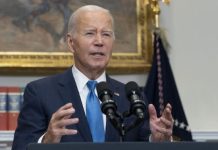
March 6 (UPI) — Travel restrictions and lockdowns can be inconvenient, if not draconian, but a study published Friday suggests the limited benefits from them, in China at least, likely protected those in Wuhan and slowed the ongoing COVID-19 outbreak from being far worse.
The analysis, published in the journal Science, says the lockdown approach taken by Chinese officials on Jan. 23, one month after the start of the outbreak in Wuhan, delayed progression of the epidemic in China by three to five days — and may have reduced the number of cases globally by mid-February by as much as 80 percent.
Johns Hopkins University, as of 3:30 p.m. ET on Friday, reported 101,765 confirmed cases of the virus globally, but 67,592 of them in Hubei province China, where Wuhan — the epicenter of the outbreak — is located. The rest of the country has reported 13,015 cases.
Chinese officials imposed a strict travel ban for those in Wuhan, limiting travel into and out of the city by closing airports, train stations, mass transit systems and highways in the region. Although officials with the World Health Organization have acknowledged that the approach likely slowed the spread of the COVID-19 outbreak, they have also consistently cautioned that the possible benefits of restrictions and lockdowns need to be “balanced” against human rights.
In late January, the Trump administration took the step of “suspending entry” into the United States for all non-U.S. citizens traveling from or through China, Hong Kong and Macau. The ban took effect Feb. 2, and covered those who had been to those regions during the preceding 14-day period.
On Feb. 29, the administration augmented the ban to include Iran, which currently has 4,747 cases. The country ranks third worldwide in COVID-19 cases, behind China and South Korea, which has 6,593, according to Johns Hopkins.
In addition to the government-instituted bans, dozens of airlines grounded flights between mainland China and many parts of the world, due at least in part to declines in travel over outbreak fears. That, too, has worked to effectively restrict travel in the aftermath of the outbreak, researchers say.
The researchers derived figures from the Global Epidemic and Mobility Model, or GLEAM, an epidemic model that uses a “meta-population network approach integrated with real-world data.”
With this approach, developed by epidemiologists and mathematicians at Northeastern University and the ISI Foundation in Torino, Italy, the world is essentially divided into sub-populations around major transportation hubs, typically airports. The sub-populations are then connected by the flow of individuals traveling daily between these hubs.
Notably, the modeling revealed that travel restrictions that are anything less than comprehensive — or, incomplete — are less effective at slowing disease spread.
The authors modeled transmission based on “90 percent” travel restrictions and found that it would not be reduced. More extensive travel restrictions “will extend the period of time during which the importation of cases is greatly reduced,” they concluded.
“Moving forward, we expect that travel restrictions to COVID-19 affected areas will have modest effects, and that transmission-reduction interventions will provide greatest benefit to mitigate the epidemic,” the researchers wrote.





